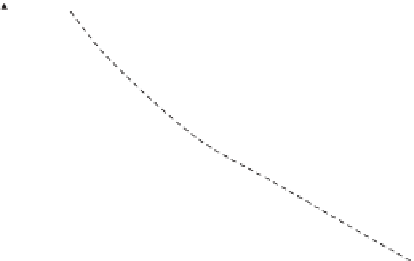Geology Reference
In-Depth Information
a)
b)
Water
Shale 'a '
Sand 'a'
Shale 'b'
AI
'
Sand 'b
Porosity
Gas sand 'a'
Gas sand 'b
Quartz
Acoustic impedance
Figure 5.10
Effect of fluid fill at different porosities in sandstones, (a) acoustic impedance vs Poisson's ratio, (b) sand porosity vs AI.
The underlying concept of how AVO might be
used to distinguish between a gas sand and a high-
porosity brine sand that have similar intercept ampli-
tudes is shown in
Fig. 5.11
. As a starting point,
consider a sand (the blue point in
Fig. 5.11a
) which
has a negative acoustic impedance contrast with an
overlying shale (the green point) (this will be referred
to as the reference sand). The AVO response of the
top of this sand is Class III and is shown in
Fig. 5.11b
.
If the porosity of the sand is increased relative to the
reference sand then the acoustic impedance contrast
becomes more negative and the intercept moves down
the AVO plot. At the same time, the AVO gradient is
less negative than the shale/reference sand response
because the shear velocity of the high-porosity sand is
less than the reference sand (but still greater than the
shale above). The effect of replacing brine with hydro-
carbon (
Fig. 5.11c
) has a similar effect on the inter-
cept (i.e. it is made more negative) but the AVO
gradient is also made more negative owing to the
increased shear velocity of the gas sand relative to
the brine filled reference sand.
Thus, the high-porosity sand can be differentiated
from the gas sand on the basis of the relative change
in AVO (
Figs. 5.11c
and
5.11f
). The amplitude ratio
of the high-porosity sand response to the reference
sand response decreases with increasing angle whilst
the gas sand/reference ratio increases (Chiburis,
1984
). This idea of AVO analysis determining a rela-
tive effect is an important one and in areas where a
laterally persistent reference horizon can be identified
with confidence, the
method can work
well (e.g. Chiburis,
1993
) (see also
Chapter 7
).
Another way of visualising the difference in AVO
effect between the gas sand and high-porosity brine
sand is to use the AVO crossplot. The data from the
AVO plot in
Fig 5.11d
is shown on the AVO crossplot
in
Fig 5.12
. Note that the brine filled points define
a trend which is inclined from left to right whereas
the gas sand plots away from this trend and down to
the left. This
'
relative AVO
'
is typical of top
hydrocarbon sand responses irrespective of the AVO
class of the brine filled sand. This is the primary effect
that is exploited in AVO analysis.
Unfortunately, it is possible for a small amount of
gas to give rise to large seismic amplitudes and AVO
anomalies. Certainly the effect is large enough to give
rise to uncertainty and ambiguity in interpretation,
particularly when considering the uncertainties in
other parameters such as porosity.
Figure 5.13
shows
the effect of variable gas and oil saturation on the
AVO response at the top of a high porosity sand.
A small amount of gas has a dramatic effect in
lowering the saturated bulk modulus, although it has
little effect on the bulk density. The bulk modulus
change has a significant effect in lowering the velocity
(
Fig. 5.13a
). With increasing gas saturation the effect
on the modulus is negligible but the density decreases.
As the density term is in the denominator of the
velocity equation (
Equ. (2.10)
), the velocity increases
with increasing gas saturation. The acoustic imped-
ance and Poisson
'
down-to-the-leftness
'
65
'
s ratio plots (
Figs. 5.13b
,
c
) show


























